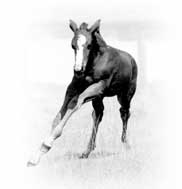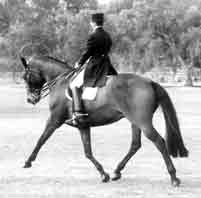|

Lateral
Thinking A/S 05
with Dr Paul McGreevy
by Amanda Macpherson
Groundbreaking new research on the equine
population is set to dispel the long held belief that right or left sidedness
is something only seen by humans.
Right: A foal’s performance career
may well be decided in the future by early testing for right or left hoofedness.
For most horse-owners, the word ‘lateral’ conjures images of
a rider in top hat and tails performing half-pass or shoulder-in on a
tall, free-striding dressage horse. While the word lateral does literally
mean ‘having to do with the side of’, it also has much more
to do with equines and riding than executing manoeuvres in the dressage
arena. Recent research into how the brain controls behaviour suggests
laterality, or lateralisation, is a phenomenon with important connotations
for horse owners, riders and trainers. Attention is being turned to finding
out if horses have the same natural tendency as humans to be more dominant
on one side than on the other.
Laterality Logistics
The brain of the horse, like most other animals, including humans, is
divided into two halves called hemispheres - the right and left hemisphere
according to which side of the skull they are located in. Unlike what
might be expected, each brain hemisphere mostly controls activity on the
opposite side of the body to its location - that is, the left hemisphere
is responsible for what happens on the right side of the body and vice
versa. This is referred to as brain lateralisation. In humans, this means
people who are right-handed are dominated by the left hemisphere of the
brain, while left-handed people are dominated by the right hemisphere.
It is also known that the right hemisphere is responsible for the expression
of intense emotions - such as fears and phobias- the memory of shapes,
mental mapping (finding the way) and problem-solving. The ability to make
choices between more than one alternative resource (for example, the choice
between ‘staying put’ and exploring - is the grass really greener
on the other side of the fence?) and the manipulation of objects in a
physical sense (such as undoing the knot in the lead rope) are under the
control of the left hemisphere.
Which side of the brain is being used at any one time can be identified
by recording any patterns of behaviour that show a right or left bias
during an activity. Put simply, experiments involving watching closely
to see which hand a human puts forward to catch a ball or which paw a
rat uses to press a lever for a food reward are ways to find out which
side of the brain is dominant in the individual being tested or in a population.
Limb-preference, as is being tested in these examples for determining
right or left ‘handedness’, is a classic trait researchers have
examined in humans. But what about animals? Lateralisation of movement
(motor function) has been demonstrated under research conditions in several
species of reptiles, amphibians, birds and mammals.
 Right: In a sport such as dressage, where symmetry is desirable and patterns
need to be repeated with equal ability in both directions, an ambidextrous
horse may prove to be a better choice than those with a strong left or
right bias. Right: In a sport such as dressage, where symmetry is desirable and patterns
need to be repeated with equal ability in both directions, an ambidextrous
horse may prove to be a better choice than those with a strong left or
right bias.
Individual Differences
With straightness and balance being essential ingredients for success
in most equestrian pursuits, many esteemed trainers - including Reiner
Klimke in his renowned publication Basic Training of the Young Horse -
have noted that horses seem to have a ‘good side’ and a ‘bad
side’, this persisting even when they have reached the more advanced
levels in their training. Given this awareness amongst the upper echelon
in the performance horse world, particularly within the dressage fraternity,
it may come as somewhat of a surprise that there hasn’t been much
actual research done on laterality in horses. Surely if riders and trainers
often notice that horses ‘just seem to go better’ in one direction,
there should be a case for investigating why this is so and whether it
is possible to identify a horse more accurately as right-hoofed, left-hoofed
or ambidextrous (use either equally)? When there also seems to be other
anecdotal evidence to support lateralisation in horses during activities
such as grazing or lying down, the potential applications of this knowledge
become quite exciting.
For example, imagine if the motor bias or ‘hoofedness’ of a
particular horse could be identified before its career path had been chosen
and embarked on to ensure it was being directed into the pursuit best
suited to its natural tendencies? If a sport such as dressage was being
contemplated, where symmetry is desirable and patterns need to be repeated
with equal ability in both directions, an ambidextrous horse may prove
to be a better choice than those with a strong left or right bias. In
the racing industry, the direction in which races are run could influence
a trainer to enter horses known to be dominant ‘right-hoofers’
only in races conducted in a clockwise (right) direction- the awareness
that they are likely to record a faster time being the motivating factor
in avoiding events staged in the other direction. Obviously, this would
then apply in reverse - the ‘left-hoofer’ being more suited
to racing on a track requiring an anti-clockwise way of travelling.
Another possibility with important implications is using a knowledge of
laterality to reduce the risk of injury and to maximise a horse’s
potential for a successful return to performance after a setback in training
or competition. If a motor bias - definite left, right or equal brain
hemisphere preference - could be pre-determined, eventually this could
lead to the owner and trainer being able to predict more accurately what
type of training would enable a particular horse to return to its full
potential and/or improve their ability to guide its rehabilitation following
injury by directing extra attention towards strengthening the weaker,
non-preferred side. In terms of keeping costs to a minimum and reducing
the likelihood of re-injury during a return to work, this would no doubt
be an attractive proposition for the majority of performance horse owners.
Temperament and Trainability.
In other animals, such as monkeys and rats, limb preference has been found
to be associated with certain features of their temperament; left-handedness
with fearfulness and right-handedness with a greater willingness to approach
and explore novel objects or surroundings. Considering the possibility
that similar links may apply to equines, there may be important applications
owners and trainers need to be aware of when making their selection of
a horse for a certain discipline or type of work. It may also be that
‘hoofedness’ could become a basis for designing training strategies
to accommodate differences in temperament.
The way a horse reacts to people, its tendency for flight and its nervousness
(emotionality) affect nearly all aspects of its life- how often it eats,
drinks and excretes, whether it gallops and snorts around the paddock
or just mooches along, quietly grazing. More importantly, to humans, the
emotionality of an individual horse has a significant influence on its
ability to learn or, in other words, its trainability and how well it
is likely to perform in different careers. For instance, Thoroughbreds
need to be highly reactive to factors in their racing environment to ‘boost’
their ability to perform well but this same trait is not so desirable
in a hack or dressage horse, as anyone who has re-trained an ex-galloper
will agree! Therefore, it may well be that the ‘right-hoofer’
- with its comparatively bold and ‘adventurous’ temperament
- has the better chance of having a successful career on the racetrack
with the ‘left-hoofer’ perhaps being more mentally comfortable
with the prospect of working calmly within the secure interior of an arena
or going for a relaxing trail ride in the quietness of the bush!
Born To Be Biased
When it comes to looking for a possible link between laterality and genetics
in equines, a starting point for reference is again the previous research
that has been done with humans and on other animals. For example, in humans,
it has been found that two left-handed parents are three to four times
more likely to have a left-handed child than two right-handed parents.
Of course, it can be hard to distinguish genetic effects from influences
in the environment, meaning there is a possibility of children copying
their left-handed parents rather than their hand dominance being inherited.
 Left: Activities such as grazing, lying down or getting up are supported by
anecdotal evidence of the horse being right-hoofed, left-hoofed or ambidextrous
(use either equally). Left: Activities such as grazing, lying down or getting up are supported by
anecdotal evidence of the horse being right-hoofed, left-hoofed or ambidextrous
(use either equally).
In relation to horses, there are ways in which their environment could
potentially influence ‘hoofedness’ - starting with the manner
in which they are housed and handled. Apart from when being ridden, many
performance horses have little opportunity to canter or gallop freely
due to being kept in stables and small yards. Therefore, it would be hard
to identify what had contributed the most - genetics or environment -
to shaping any limb dominance tendencies a horse might display when at
liberty in a paddock. Also, conventionally, horses are handled almost
exclusively from one side only - this being the near or left side - so
this may explain to some extent any side bias shown. As studies on other
animals, such as rats have shown that even a minimal amount of handling
causes a significant shift in their paw preference or ‘handedness’,
this suggests it may be an area of research worth following up in relation
to the equine population. Comparison of limb dominance in foals both before
and after handling could be a valuable way of shedding some light on this
subject.
The breed of a horse, especially when it is the one favoured for a particular
activity, could also have an influence on its limb dominance. Given the
tendencies for Thoroughbreds to be raced, Warmbloods used for dressage,
Quarter Horses for cutting, Arabians for endurance and so on, it is interesting
to speculate if there may be a higher proportion of individuals with a
certain ‘hoofedness’ in these groupings than compared with the
general horse population. Taking this line of thinking a step further
and considering the link between laterality and nervousness, it could
even be that breeders have unintentionally skewed factors such as limb
dominance by intentionally selecting horses with certain temperaments
for different disciplines and uses.
Finally, a horse’s sex may well be an indication of its ‘hoofedness’,
given that a recent study conducted in Ireland has shown male horses to
possess a higher directional bias to the left and females a higher preference
for the right leg. These results mirror the findings made during studies
on dogs and primates so are a worthwhile addition to the growing pile
of statistics that indicate laterality is a trait no longer solely thought
of as only human.
Through studies such as these and others now taking place, more is being
learned not only about sidedness in horses and its possible links to issues
such as lameness, but also in relation to the specific roles the two brain
hemispheres play in behaviour, trainability and performance.
 Dr
Paul McGreevy Dr
Paul McGreevy
A Senior Lecturer in Animal Behaviour at the University of Sydney’s
Faculty of Veterinary Science, Dr McGreevy draws on his knowledge and
experience as a riding instructor, veterinary surgeon and behavioural
scientist for his work.
|